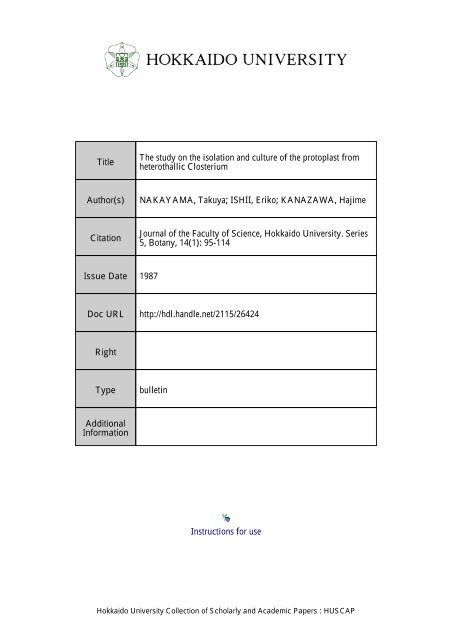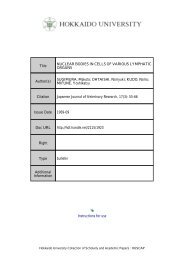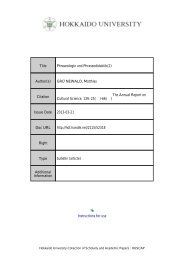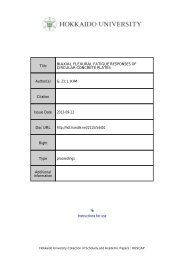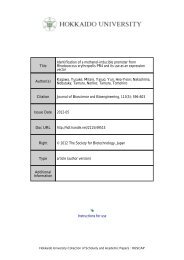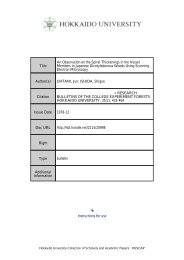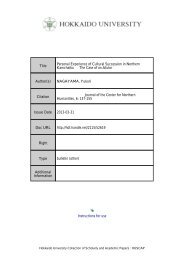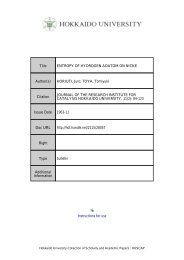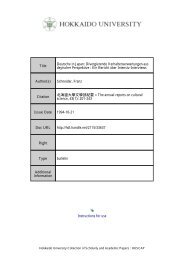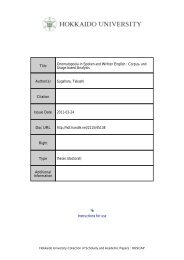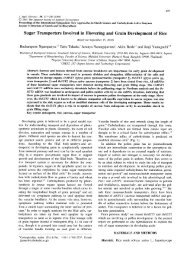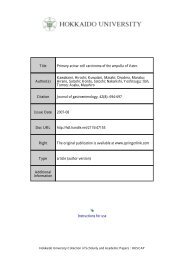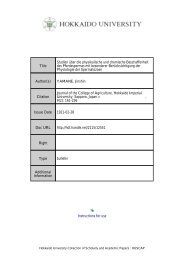The study on the isolation and culture of the protoplast from ...
The study on the isolation and culture of the protoplast from ...
The study on the isolation and culture of the protoplast from ...
You also want an ePaper? Increase the reach of your titles
YUMPU automatically turns print PDFs into web optimized ePapers that Google loves.
Journ. Fac. Sci., Hokkaido Univ. Ser. V (Botany), 14(1): 95-114, 1987.<br />
<str<strong>on</strong>g>The</str<strong>on</strong>g> <str<strong>on</strong>g>study</str<strong>on</strong>g> <strong>on</strong> <strong>the</strong> isolati<strong>on</strong> <strong>and</strong> <strong>culture</strong> <strong>of</strong> <strong>the</strong> <strong>protoplast</strong><br />
<strong>from</strong> heterothallic Closterium<br />
Takuya N AKA Y AMA, Eriko ISHII<br />
<strong>and</strong> Hajime KAN AZA W A<br />
<str<strong>on</strong>g>The</str<strong>on</strong>g> enzymatic isolati<strong>on</strong> <strong>of</strong> <strong>protoplast</strong>s <strong>and</strong> <strong>the</strong>ir <strong>culture</strong> were studied in heterothallic<br />
strains <strong>of</strong> Closterium peracerosum-strigosum-littorale complex. <str<strong>on</strong>g>The</str<strong>on</strong>g> digesti<strong>on</strong> <strong>of</strong> <strong>the</strong>ir cell<br />
walls proceeded <strong>from</strong> divisi<strong>on</strong> scars distributed al<strong>on</strong>g <strong>the</strong> cell wall, <strong>and</strong> <strong>protoplast</strong>s were<br />
released out <strong>from</strong> <strong>on</strong>e <strong>of</strong> <strong>the</strong>se scars with remaining porti<strong>on</strong>s <strong>of</strong> <strong>the</strong> cell wall undigested.<br />
<str<strong>on</strong>g>The</str<strong>on</strong>g> yield <strong>of</strong> <strong>the</strong> <strong>protoplast</strong> varied according to cell age. When "post<strong>culture</strong>" (stati<strong>on</strong>ary<br />
<strong>culture</strong> with fresh medium overnight) was carried out prior to enzyme treatment, <strong>protoplast</strong>s<br />
were obtained in high yield <strong>from</strong> <strong>the</strong> cells <strong>of</strong> various ages. <str<strong>on</strong>g>The</str<strong>on</strong>g> maximum yields<br />
<strong>of</strong> <strong>the</strong> <strong>protoplast</strong> <strong>of</strong> mt+- <strong>and</strong> mC-cells were 80-90% <strong>and</strong> 70-80%, respectively, in this <str<strong>on</strong>g>study</str<strong>on</strong>g>.<br />
<str<strong>on</strong>g>The</str<strong>on</strong>g> cultivati<strong>on</strong> <strong>of</strong> <strong>protoplast</strong>s in <strong>the</strong> presence <strong>of</strong> 100 mM CaCl, led <strong>the</strong>m to initiate <strong>the</strong><br />
regenerati<strong>on</strong> <strong>of</strong> <strong>the</strong> cell walls. Scanning electr<strong>on</strong> microscopy revealed that <strong>the</strong> early stages<br />
<strong>of</strong> <strong>the</strong> cell wall regenerati<strong>on</strong> in this alga was similar to that in higher plants. Several<br />
physiological phenomena c<strong>on</strong>cerning <strong>the</strong> <strong>culture</strong> <strong>of</strong> <strong>the</strong> <strong>protoplast</strong>s <strong>of</strong> this alga were also<br />
examined.<br />
Protoplasts have been isolated enzymatically <strong>from</strong> many kinds <strong>of</strong> plants,<br />
<strong>culture</strong>d <strong>and</strong> regenerated into new individuals. <str<strong>on</strong>g>The</str<strong>on</strong>g>n <strong>the</strong>y have been used<br />
routinely as an important experimental tool in <strong>the</strong> underst<strong>and</strong>ing <strong>of</strong> physiology,<br />
development <strong>and</strong> morphogenesis <strong>of</strong> plant cells. Most <strong>of</strong> <strong>the</strong>se studies,<br />
however, have been d<strong>on</strong>e with higher plants, <strong>and</strong> <strong>protoplast</strong>s <strong>of</strong> lower plants<br />
have received less attenti<strong>on</strong>.<br />
Recently <strong>protoplast</strong>s have been isolated <strong>from</strong> many eukaryotic algae<br />
(reviewed by BERLINER, 1981, 1983). With regard to desmids, <strong>protoplast</strong>s<br />
have been derived <strong>from</strong> Cosmarium (CHARDARD, 1972), Micrasterias (BERLINER<br />
<strong>and</strong> WENC, 1976), Staurastrum <strong>and</strong> Netrium (BERLINER, 1978). For <strong>the</strong><br />
Closterium species, <strong>protoplast</strong>s have been isolated in C. acerosum (BERLINER,<br />
1978) <strong>and</strong> C. peracerosum-strigosum-littorale complex (KATO et al., 1983). All<br />
<strong>the</strong>se reports described mainly <strong>protoplast</strong> obtenti<strong>on</strong>s, but dealt little with<br />
<strong>culture</strong>s <strong>and</strong> regenerati<strong>on</strong>s <strong>of</strong> <strong>protoplast</strong>.<br />
Closterium species are interesting materials to <str<strong>on</strong>g>study</str<strong>on</strong>g> some biological<br />
problems. Several workers have studied morphologically, physiologically<br />
<strong>and</strong> genetically about several problems using Closterium. Use <strong>of</strong> <strong>protoplast</strong><br />
may c<strong>on</strong>tribute to <strong>the</strong>se studies. For example, <strong>the</strong> <strong>protoplast</strong> may be used to
Protoplasts <strong>from</strong> Closterium 97<br />
Culture <strong>of</strong> <strong>protoplast</strong><br />
After enzyme treatment for 3 h, <strong>protoplast</strong>s were harvested by centrifugati<strong>on</strong><br />
(50 X g, 1.5 min), washed twice with <strong>protoplast</strong> <strong>culture</strong> medium,<br />
that is, <strong>the</strong> C-medium c<strong>on</strong>taining 0.1 M CaCl2 <strong>and</strong> 0.3 M sorbitol, <strong>and</strong> resuspended<br />
in <strong>the</strong> same medium. <str<strong>on</strong>g>The</str<strong>on</strong>g> cells were <strong>culture</strong>d in 4 well multidishes<br />
(NUNC No. 134673) stood stati<strong>on</strong>ary under a regime <strong>of</strong> 16 h <strong>of</strong> light (25" C) at<br />
various light intensity (darkness, ca. 700 lux, ca. 3,000 lux) <strong>and</strong> 8 h <strong>of</strong> darkness<br />
(20" C). <str<strong>on</strong>g>The</str<strong>on</strong>g> cell density was adjusted to 5.2 x 10 4 cells in <strong>the</strong> 400 til medium<br />
per a well.<br />
Detecti<strong>on</strong> <strong>of</strong> cell wall <strong>and</strong> determinati<strong>on</strong> <strong>of</strong> viability <strong>of</strong> <strong>protoplast</strong><br />
Calc<strong>of</strong>luor White M2R (Polysciences, Inc., Warringt<strong>on</strong>) dissolved in <strong>the</strong><br />
<strong>protoplast</strong> <strong>culture</strong> medium was used to stain <strong>the</strong> cell wall to c<strong>on</strong>firm that<br />
isolated <strong>protoplast</strong>s had no cell wall. This dye was also used to follow <strong>the</strong><br />
process <strong>of</strong> cell wall regenerati<strong>on</strong> <strong>of</strong> <strong>protoplast</strong>.<br />
To examine <strong>protoplast</strong> viability, <strong>the</strong> <strong>protoplast</strong>s were observed with an<br />
inverted microscope during <strong>the</strong> <strong>protoplast</strong> <strong>culture</strong>. <str<strong>on</strong>g>The</str<strong>on</strong>g> living <strong>protoplast</strong>s<br />
could be easily distingushed <strong>from</strong> <strong>the</strong> died <strong>on</strong>e, because <strong>the</strong> living cell was<br />
round in shape, had smooth membrane, had a bright green color, <strong>and</strong> had a<br />
uniform cytoplasm, although <strong>the</strong> died <strong>on</strong>e lost its round shape <strong>and</strong> bright<br />
green color, had small droplets or vesicles associated with <strong>the</strong> wrinkled<br />
membrane, <strong>and</strong> had a granulated cytoplasm. <str<strong>on</strong>g>The</str<strong>on</strong>g> viability determined by<br />
<strong>the</strong> observati<strong>on</strong> <strong>of</strong> <strong>the</strong>se points c<strong>on</strong>sisted with <strong>the</strong> results <strong>from</strong> <strong>the</strong> observati<strong>on</strong><br />
using fluorescein diacetate (Sigma chemical Co.) or phenosafranine<br />
(Wako Pure Chemical Industries, Ltd.) according to WIDHOLM (1972).<br />
Electr<strong>on</strong> microscopic observati<strong>on</strong><br />
Protoplasts attached <strong>on</strong> a cover glass coated with poly-L-Iysine were<br />
fixed in 1% (w/v) glutaraldehyde prepared in 0.1 M cacodylate buffer (pH 7.4)<br />
c<strong>on</strong>taining 0.4 M sorbitol overnight or l<strong>on</strong>ger at 4" C. After rinse in buffer<br />
soluti<strong>on</strong> <strong>the</strong>y were postfixed for 1 h in 1% (w/v) osmium tetraoxide prepared<br />
in 0.1 M cacodylate buffer (pH 7.4) at 4" C, rinsed with water, <strong>and</strong> dehydrated<br />
through an ethanol series (30%, 50%, 70%, 80%, 90%, 100%, 100%). Samples<br />
were <strong>the</strong>n dried at critical point <strong>from</strong> carb<strong>on</strong> dioxide. <str<strong>on</strong>g>The</str<strong>on</strong>g> cover glass with<br />
dried <strong>protoplast</strong>s was mounted <strong>on</strong> a stub <strong>and</strong> coated with gold using an i<strong>on</strong><br />
sputter JEOL JFC-llOO. Specimens were examined in a JEOL JSM-T20<br />
scanning electr<strong>on</strong> microscope with an accelerating voltage <strong>of</strong> 20 KV for low<br />
magnificati<strong>on</strong> <strong>and</strong> in a JEOL JSM-U3 scanning electr<strong>on</strong> microscope with an<br />
accelerating voltage <strong>of</strong> 25 KV for high magnificati<strong>on</strong>.
98<br />
T. Nakayama, E. Ishii <strong>and</strong> H. Kanazawa<br />
Results<br />
<str<strong>on</strong>g>The</str<strong>on</strong>g> process <strong>of</strong> <strong>protoplast</strong> formati<strong>on</strong><br />
Fig. 1 shows <strong>the</strong> typical process <strong>of</strong> <strong>protoplast</strong> formati<strong>on</strong>. It seems <strong>the</strong><br />
<strong>protoplast</strong> comes out <strong>from</strong> <strong>the</strong> specifically digested part <strong>of</strong> <strong>the</strong> cell wall.<br />
First, it was observed <strong>the</strong> cell membrane swelled out <strong>of</strong> <strong>the</strong> digested positi<strong>on</strong><br />
slightly distant <strong>from</strong> <strong>the</strong> nucleus (Figs. lA, 2A, arrow). This positi<strong>on</strong> seems<br />
to be <strong>the</strong> same place as that where <strong>the</strong> c<strong>on</strong>jugati<strong>on</strong> papilla (ICHIMURA, 1971)<br />
is formed during <strong>the</strong> mating process. As can be seen in Fig. 2B (arrow 1), <strong>the</strong><br />
cell wall at this positi<strong>on</strong> is specifically digested <strong>and</strong> <strong>the</strong> swelling prove to be<br />
<strong>of</strong> <strong>the</strong> cell membrane because this positi<strong>on</strong> dosen't fluoresce by Calc<strong>of</strong>luor<br />
White. In additi<strong>on</strong> to this place, al10<strong>the</strong>r part <strong>of</strong> <strong>the</strong> cell wall is also digested<br />
specifically (Fig. 2B, arrow 2). All <strong>the</strong>se specifically digested parts <strong>of</strong> <strong>the</strong><br />
cell wall corresp<strong>on</strong>d to <strong>the</strong> divisi<strong>on</strong> scars which are <strong>the</strong> sutures between new<br />
<strong>and</strong> old semicell walls occurred by cell divisi<strong>on</strong>. Next, <strong>the</strong> swelling increased<br />
in size <strong>and</strong> each semicell protoplasm c<strong>on</strong>tracted into <strong>the</strong> swelling (Fig. 1B<br />
-E). At last, <strong>the</strong> cell wall was broken <strong>and</strong> divided into two or more pieces,<br />
<strong>and</strong> <strong>the</strong> <strong>protoplast</strong> was released (Fig. IF - J). Just after releasing <strong>the</strong> <strong>protoplast</strong>,<br />
<strong>the</strong> cell wall avoiding complete digesti<strong>on</strong> was remained (Fig. 1 I, J,<br />
arrows).<br />
It is known <strong>the</strong> case that 0.1-10 mM calcium i<strong>on</strong> was added to <strong>the</strong> enzyme<br />
soluti<strong>on</strong> to protect <strong>the</strong> <strong>protoplast</strong> membrane against any injuries during<br />
<strong>protoplast</strong> isolati<strong>on</strong> (OHIWA, 1977; KAMEYA et al., 1981; BATES et al., 1983;<br />
VERHOEK-KoHLER et al., 1983). <str<strong>on</strong>g>The</str<strong>on</strong>g>refore we tested <strong>the</strong> effects <strong>of</strong> calcium<br />
i<strong>on</strong> <strong>on</strong> <strong>protoplast</strong> isolati<strong>on</strong>. When 3 mM Ca 2 + was present in <strong>the</strong> mixture <strong>of</strong><br />
cells <strong>and</strong> enzyme soluti<strong>on</strong>, <strong>protoplast</strong> formati<strong>on</strong> was completely inhibited,<br />
while <strong>the</strong> formati<strong>on</strong> was not inhibited by 30 mM K+ <strong>and</strong> was inhibited slightly<br />
by 30 mM Mg 2+ (Table 1). Fig. 3 shows that <strong>the</strong> cell wall is preserved<br />
completely <strong>from</strong> <strong>the</strong> enzymatic digesti<strong>on</strong> in <strong>the</strong> presence <strong>of</strong> calcium i<strong>on</strong> <strong>and</strong><br />
protoplasm c<strong>on</strong>tracts as a result <strong>of</strong> plasmolysis.<br />
Effects <strong>of</strong> sugar c<strong>on</strong>centrati<strong>on</strong> in enzyme soluti<strong>on</strong> <strong>on</strong> <strong>protoplast</strong> yield<br />
For <strong>the</strong> optimizati<strong>on</strong> <strong>of</strong> c<strong>on</strong>diti<strong>on</strong>s for <strong>protoplast</strong> preparati<strong>on</strong>, it was<br />
found that <strong>the</strong> c<strong>on</strong>centrati<strong>on</strong> <strong>of</strong> sorbitol used as an osmotic stabilizer was <strong>on</strong>e<br />
Fig.1. <str<strong>on</strong>g>The</str<strong>on</strong>g> process <strong>of</strong> <strong>protoplast</strong> formati<strong>on</strong>. A-I: A course <strong>of</strong> <strong>protoplast</strong> formati<strong>on</strong>.<br />
A, <strong>the</strong> c<strong>on</strong>jugati<strong>on</strong> papilla-like swelling formati<strong>on</strong>; B<strong>and</strong> C, <strong>the</strong> swelling<br />
increased in size; D-H, <strong>the</strong> c<strong>on</strong>tracting protoplasm <strong>and</strong> <strong>the</strong> separating cell<br />
wall; I, a <strong>protoplast</strong> just released <strong>and</strong> remaining cell wall without <strong>the</strong> complete<br />
digesti<strong>on</strong> (arrows). J: Ano<strong>the</strong>r example <strong>of</strong> <strong>protoplast</strong> release without<br />
<strong>the</strong> complete digesti<strong>on</strong> <strong>of</strong> <strong>the</strong> cell wall (arrows). <str<strong>on</strong>g>The</str<strong>on</strong>g> bar represents 50,um.
Protoplasts <strong>from</strong> Closterium 99
100<br />
T. Nakayama, E. Ish ii <strong>and</strong> H. Kanazawa<br />
<strong>of</strong> <strong>the</strong> keys to obtain high yield <strong>of</strong> <strong>the</strong> <strong>protoplast</strong>. Fig. 4 shows that <strong>the</strong> most<br />
effective c<strong>on</strong>centrati<strong>on</strong> <strong>of</strong> sorbitol is 0.3 M. <str<strong>on</strong>g>The</str<strong>on</strong>g> <strong>protoplast</strong> yield reached its<br />
maximum level within 3 h <strong>of</strong> incubati<strong>on</strong> when 0.3 M sorbitol was used. It<br />
took 4 h in 0.4 M sorbitol <strong>and</strong> 5 h or l<strong>on</strong>ger in 0.5 M sorbitol to attain full<br />
release <strong>of</strong> <strong>the</strong> <strong>protoplast</strong>. In both cases, <strong>the</strong> yields were lower than that <strong>of</strong><br />
0.3 M sorbitol. Final 0.2 or 0.1 M sorbitol was too hypot<strong>on</strong>ic to obtain <strong>the</strong><br />
Fig. 2. Partial digesti<strong>on</strong> <strong>of</strong> <strong>the</strong> cell wall. A: <str<strong>on</strong>g>The</str<strong>on</strong>g> phase c<strong>on</strong>trast microscopy <strong>of</strong> a<br />
c<strong>on</strong>jugati<strong>on</strong> papilla-like swelli ng (arrow). B: <str<strong>on</strong>g>The</str<strong>on</strong>g> same cell stained with<br />
Calc<strong>of</strong>luor White ; note that <strong>the</strong> cell wall is specificall y digested at two points<br />
(arrows I, 2).<br />
Fig. 3. <str<strong>on</strong>g>The</str<strong>on</strong>g> undigested cell wall (arrows) in <strong>the</strong> presence <strong>of</strong> Ca H<br />
observed by a phase c<strong>on</strong>trast microscope.
Protoplasts <strong>from</strong> Closterium 101<br />
<strong>protoplast</strong>.<br />
<str<strong>on</strong>g>The</str<strong>on</strong>g> combinati<strong>on</strong> <strong>of</strong> 1% (w/v) cellulase <strong>and</strong> 0.5% (w/v) macerozyme was<br />
appropriate for <strong>protoplast</strong> formati<strong>on</strong>.<br />
Under <strong>the</strong> optimum c<strong>on</strong>diti<strong>on</strong>s including <strong>the</strong> best cell <strong>culture</strong> c<strong>on</strong>diti<strong>on</strong> as<br />
described below for <strong>protoplast</strong> preparati<strong>on</strong>, <strong>the</strong> yield <strong>of</strong> <strong>protoplast</strong> reached its<br />
maximum level, 80-90% in mt+- <strong>and</strong> 70-80% in mt--cells, within 3 h <strong>of</strong> incubati<strong>on</strong><br />
(Fig. 4)_ In general, <strong>the</strong> yield <strong>of</strong> <strong>protoplast</strong> was higher in mt+- than mt-cells<br />
(Figs. 4, 5, Table U-<br />
Table 1 Effects <strong>of</strong> cati<strong>on</strong>s <strong>on</strong> <strong>protoplast</strong> yields<br />
salts<br />
Yields <strong>of</strong> Protoplast (%)<br />
3 mM CaCl,.2H,O 2.2± 1.2 3.9±0.6<br />
30 mM CaCl,.2H,O 0.3±0.2 0.2±0.2<br />
30 mM Ca(NO,),·4H 2O 0.3± 0.4 0.9±0.5<br />
30 mM KCl 86.4 ± 1.6 79.1 ±3.9<br />
30 mM MgCl,·6H,O 62.7±4.5 46.2±9.3<br />
c<strong>on</strong>trol 88.2±0.9 72.7±2.6<br />
Cells harvested after 6 days <strong>of</strong> growth <strong>culture</strong> were<br />
"post<strong>culture</strong>d" overnight <strong>and</strong> treated for 3 h with <strong>the</strong><br />
st<strong>and</strong>ard enzyme soluti<strong>on</strong> c<strong>on</strong>taining each salt shown<br />
above. <str<strong>on</strong>g>The</str<strong>on</strong>g> results given are <strong>the</strong> averages ± st<strong>and</strong>ard<br />
deviati<strong>on</strong>s <strong>from</strong> three independent experiments.<br />
Effects <strong>of</strong> <strong>the</strong> growth <strong>culture</strong> c<strong>on</strong>diti<strong>on</strong> <strong>on</strong> <strong>protoplast</strong> yield<br />
Protoplasts were derived more effectively <strong>from</strong> "post<strong>culture</strong>d" cells than<br />
<strong>from</strong> cells without "post<strong>culture</strong>". <str<strong>on</strong>g>The</str<strong>on</strong>g> yield <strong>of</strong> <strong>protoplast</strong> became higher by<br />
a stati<strong>on</strong>ary <strong>culture</strong> <strong>on</strong>ly prior to enzyme treatment without refreshing <strong>the</strong><br />
medium than by a c<strong>on</strong>tinuous rotary shaking. And <strong>the</strong> yield <strong>of</strong> <strong>protoplast</strong><br />
reached <strong>the</strong> maximum level when cells were "post<strong>culture</strong>d" overnight in <strong>the</strong><br />
fresh C-medium without shaking (Fig_ 5)_<br />
<str<strong>on</strong>g>The</str<strong>on</strong>g> yield <strong>of</strong> <strong>protoplast</strong> was depended <strong>on</strong> age <strong>of</strong> <strong>the</strong> cells. As shown in<br />
Fig. 5, <strong>protoplast</strong>s were obtained most effectively about 5 or 6 days after <strong>the</strong><br />
start <strong>of</strong> <strong>culture</strong>, corresp<strong>on</strong>ding to middle-late log phase <strong>of</strong> growth, whe<strong>the</strong>r<br />
"post<strong>culture</strong>d" or not. Without "post<strong>culture</strong>", <strong>the</strong> yield increased until <strong>the</strong><br />
peak <strong>of</strong> <strong>the</strong> 5th <strong>and</strong> 6th day <strong>of</strong> <strong>culture</strong> for mt-- <strong>and</strong> mt+-cells, respectively, <strong>and</strong><br />
<strong>the</strong>n decreased gradually with aging. With "post<strong>culture</strong>", however, <strong>protoplast</strong>s<br />
could be isolated in c<strong>on</strong>tinuously high yields between <strong>the</strong> 5th <strong>and</strong> 8th<br />
day <strong>of</strong> <strong>culture</strong> in mt--cells <strong>and</strong> between <strong>the</strong> 6th <strong>and</strong> 9th day <strong>of</strong> <strong>culture</strong> in mt+-
Protoplasts <strong>from</strong> Closterium<br />
were observed even in <strong>the</strong> same preparati<strong>on</strong>. <str<strong>on</strong>g>The</str<strong>on</strong>g> cell wall regenerati<strong>on</strong><br />
during 4 days <strong>of</strong> <strong>culture</strong> proceeded as follows.<br />
As shown in Fig. 9, freshly isolated <strong>protoplast</strong> had smooth <strong>and</strong> uniform<br />
surfaces. First, many small projecti<strong>on</strong>s appeared <strong>on</strong> <strong>the</strong> cell surface as<br />
described in higher plants, tobacco <strong>and</strong> grapevine (BURGRESS <strong>and</strong> LiNSTEAD,<br />
1976)(Fig. 10, arrowheads). Next, <strong>the</strong> fibrillar structures appeared (Fig. 11)<br />
<strong>and</strong> some <strong>of</strong> which seemed to be associated with small projecti<strong>on</strong>s (Fig. 11,<br />
arrowheads). <str<strong>on</strong>g>The</str<strong>on</strong>g>n <strong>the</strong> fibers el<strong>on</strong>gated to be entangled gradually (Figs. 12,<br />
13). And big spherical projecti<strong>on</strong>s sometimes became to be seen (Fig. 14,<br />
arrowheads). At <strong>the</strong> 4th day <strong>of</strong> <strong>culture</strong>, <strong>the</strong> fibers became to be well den sed<br />
<strong>and</strong> made <strong>the</strong> fibrous mat over whole cell surface (Fig. 15A, B). But in some<br />
cases, <strong>the</strong> fibers c<strong>on</strong>centrated <strong>on</strong> a certain part <strong>of</strong> <strong>the</strong> cell surface <strong>and</strong> made<br />
fibrous mats (Fig. 16, arrowheads) which could be detected with Calc<strong>of</strong>luor as<br />
blue-white fluorescing spots. However, <strong>the</strong> complete cell wall as seen In<br />
vegetative cell couldn't be observed within 4 days <strong>of</strong> <strong>culture</strong>.<br />
Fig_ 9_ Scanning electr<strong>on</strong> microscopy <strong>of</strong> freshly isolated mt+-<strong>protoplast</strong>s.<br />
A: Whole cells, X 1,300. B: A part <strong>of</strong> cell<br />
surface (<strong>the</strong> furrows are <strong>the</strong> artifacts which occurred<br />
during <strong>the</strong> observati<strong>on</strong>), x 20,000.<br />
107
108<br />
Fig. 10. Scanning electr<strong>on</strong> microscopy <strong>of</strong> <strong>the</strong> mt+·<strong>protoplast</strong><br />
<strong>culture</strong>d for 2 days. Many small projecti<strong>on</strong>s are seen <strong>on</strong><br />
<strong>the</strong> cell surface (arrowheads). X 20.000.<br />
Fig.11. Scanning electr<strong>on</strong> microscopy <strong>of</strong> <strong>the</strong> mt+·<strong>protoplast</strong><br />
<strong>culture</strong>d for 2 days. Fibrillar structures, some <strong>of</strong> which<br />
seem to be associated with sma ll projecti<strong>on</strong>s, are seen<br />
(arrowheads). x 20,000.
Fig. 12. Scanning electr<strong>on</strong> microscopy <strong>of</strong> <strong>the</strong> mt+·<strong>protoplast</strong><br />
<strong>culture</strong>d for 2 days. <str<strong>on</strong>g>The</str<strong>on</strong>g> fibers increase in number. x 20,<br />
000.<br />
Fig. 13. Scanning electr<strong>on</strong> microscopy <strong>of</strong> <strong>the</strong> mt-·<strong>protoplast</strong><br />
<strong>culture</strong>d for 4 days. El<strong>on</strong>gated <strong>and</strong> entangled fibers are<br />
seen. x 20,000.<br />
109
110 T. Nakayama. E.lshii <strong>and</strong> H. Kanazawa<br />
Fig. 14. Scanning electr<strong>on</strong> microscopy <strong>of</strong> <strong>the</strong> mt-·<strong>protoplast</strong> <strong>culture</strong>d for 4 days. Big<br />
projecti<strong>on</strong>s (arrowheads) <strong>and</strong> well developed fibers are seen. x 10,000.<br />
Fig. 15. Scanning electr<strong>on</strong> microscopy <strong>of</strong> <strong>the</strong> mt-'<strong>protoplast</strong> <strong>culture</strong>d for 4 days.<br />
Fibrous mat over whole cell surface made by densed fibers are seen. A:<br />
Whole cell , x 5,000. B: A part <strong>of</strong> cell surface, x 20,000.
Protoplasts <strong>from</strong> Closterium<br />
Fig. 16. Scanning electr<strong>on</strong> microscopy <strong>of</strong> <strong>the</strong> mt-·<strong>protoplast</strong><br />
<strong>culture</strong>d for 4 days. <str<strong>on</strong>g>The</str<strong>on</strong>g> fibrous mats c<strong>on</strong>centrate <strong>on</strong> <strong>on</strong>e<br />
part <strong>of</strong> <strong>the</strong> cell surface (a rrowheaos). X 20.000.<br />
Discussi<strong>on</strong><br />
Site·specific digesti<strong>on</strong> <strong>of</strong> <strong>the</strong> cell wall observed here during enzymatic<br />
<strong>protoplast</strong> isolati<strong>on</strong> is thought to be comm<strong>on</strong> nature to Closterium species<br />
because <strong>the</strong> site is <strong>the</strong> di visi<strong>on</strong> scars which exist <strong>on</strong> <strong>the</strong> cell wall <strong>of</strong> all<br />
Closterium species. Only <strong>on</strong>e <strong>protoplast</strong> per cell was observed in this species<br />
used here, although in some cases two <strong>protoplast</strong>s emerged <strong>from</strong> <strong>on</strong>e cell<br />
whose cytoplasm was already divided in two while <strong>the</strong> cell wall was not<br />
divided, just before cell divisi<strong>on</strong>. However, BERLINER (1978) reported that<br />
more than <strong>on</strong>e <strong>protoplast</strong> per cell was frequently released in C. acerosum. It<br />
is thought that <strong>the</strong>y would emerge out <strong>of</strong> different digested parts <strong>of</strong> divisi<strong>on</strong><br />
scars at <strong>the</strong> same time, <strong>and</strong> that <strong>on</strong>ly <strong>on</strong>e <strong>of</strong> <strong>the</strong>m would be nucleated <strong>and</strong> <strong>the</strong><br />
o<strong>the</strong>rs would be cytoplast, not <strong>protoplast</strong>.<br />
<str<strong>on</strong>g>The</str<strong>on</strong>g> optimum c<strong>on</strong>centrati<strong>on</strong> <strong>of</strong> sorbitol as an osmotic stabilizer for<br />
<strong>protoplast</strong> preparati<strong>on</strong> is 0.3 M (Fig. 4). Using 0.3 M sorbitol, <strong>the</strong> yield <strong>of</strong><br />
<strong>protoplast</strong> attained its maximum level within 3 h whereas high c<strong>on</strong>centra·<br />
111
112 T. Nakayama, E. Ishii <strong>and</strong> H. Kanazawa<br />
ti<strong>on</strong>s, 0.45-0.8 M, <strong>of</strong> sorbitol used by KATO et al. (1983) needed more than 10 h<br />
to reach <strong>the</strong> maximum levels which were lower than that <strong>of</strong> 0.3 M sorbitol.<br />
BERLINER (1978) reported that <strong>the</strong> yield <strong>of</strong> <strong>protoplast</strong> varied <strong>from</strong> 30 to<br />
90%. Under <strong>the</strong> <strong>culture</strong> c<strong>on</strong>diti<strong>on</strong>s including "post<strong>culture</strong>" used here, <strong>the</strong><br />
yield is stable <strong>and</strong> high; 70-80% in mt--cells <strong>and</strong> 80-90% in mt+-cells. Thus,<br />
<strong>the</strong> "post<strong>culture</strong>" is effective to get <strong>the</strong> high yield <strong>of</strong> <strong>protoplast</strong>, especially in<br />
mt--cells. Although <strong>the</strong> reas<strong>on</strong> why "post<strong>culture</strong>" is effective is not known,<br />
<strong>the</strong> possible explanati<strong>on</strong> is as follows. It was observed that <strong>the</strong> "post<strong>culture</strong>d"<br />
cell pellet was more densed than <strong>the</strong> "n<strong>on</strong>-post<strong>culture</strong>d" <strong>on</strong>e after<br />
twice washing with water by centrifugati<strong>on</strong> before enzyme treatment. This<br />
suggests that <strong>the</strong> mucilage <strong>of</strong> cell surface is more easily taken <strong>of</strong>f by washing<br />
when <strong>the</strong> cell was "post<strong>culture</strong>d." <str<strong>on</strong>g>The</str<strong>on</strong>g>refore <strong>the</strong> enzyme soluti<strong>on</strong> can act <strong>on</strong><br />
<strong>the</strong> cell surface without <strong>the</strong> interference <strong>of</strong> mucilage, so producing <strong>protoplast</strong><br />
with higher yield. <str<strong>on</strong>g>The</str<strong>on</strong>g> reas<strong>on</strong> why <strong>the</strong> "post<strong>culture</strong>" is more effective in<br />
mt--cell is thought to be that mt--cell usually has more mucilage than mt+-cell<br />
which protect <strong>the</strong> cell wall <strong>from</strong> <strong>the</strong> acti<strong>on</strong> <strong>of</strong> exogenous enzymes, so <strong>the</strong> yield<br />
<strong>of</strong> <strong>protoplast</strong> is low without "post<strong>culture</strong>", but when <strong>the</strong> cell was "post<strong>culture</strong>d",<br />
<strong>the</strong> mucilage is taken <strong>of</strong>f <strong>and</strong> <strong>the</strong> <strong>protoplast</strong> is obtained in high<br />
yield.<br />
<str<strong>on</strong>g>The</str<strong>on</strong>g> presence <strong>of</strong> calcium i<strong>on</strong> inhibited <strong>protoplast</strong> formati<strong>on</strong> completely in<br />
Closterium (Fig. 3, Table 1). This is thought not to be <strong>on</strong>ly <strong>the</strong> inhibiti<strong>on</strong> <strong>of</strong><br />
<strong>the</strong> acti<strong>on</strong> <strong>of</strong> -<strong>the</strong> enzymes by calcium i<strong>on</strong>, because <strong>protoplast</strong>s <strong>from</strong> many<br />
kinds <strong>of</strong> plant were obtained enzymatically in <strong>the</strong> presence <strong>of</strong> calcium i<strong>on</strong><br />
(OHIWA, 1977; KAMEYA et al., 1981; BATES et al., 1983; VERHOEK-KoHLER<br />
et al., 1983). In Closterium, calcium i<strong>on</strong> may play <strong>the</strong> unknown role <strong>on</strong> <strong>the</strong><br />
compositi<strong>on</strong> <strong>of</strong> cell wall.<br />
Calcium i<strong>on</strong> played <strong>the</strong> important role(s), also in <strong>the</strong> survival <strong>of</strong> <strong>protoplast</strong><br />
<strong>and</strong> <strong>the</strong> cell wall regenerati<strong>on</strong>. When 0.1 M Ca(N03)2 was used as <strong>the</strong><br />
source <strong>of</strong> calcium i<strong>on</strong>, <strong>the</strong> viability <strong>of</strong> <strong>the</strong> <strong>protoplast</strong> was less than when 0.1<br />
M CaCl 2 was used (Fig. 7 A). This inhibiti<strong>on</strong> may be due to <strong>the</strong> excessive<br />
supply <strong>of</strong> nitrogen. When <strong>the</strong> medium c<strong>on</strong>taining 0.55 M sorbitol, which was<br />
isot<strong>on</strong>ic to 0.1 M CaCl2 + 0.3 M sorbitol, was used for <strong>protoplast</strong> <strong>culture</strong>, all<br />
<strong>protoplast</strong>s bursted to die within 2 days <strong>of</strong> <strong>culture</strong>. When <strong>the</strong> medium<br />
c<strong>on</strong>taining 0.1 M MgClz+0.3 M sorbitol was used, almost all <strong>protoplast</strong> died<br />
within 2 days although <strong>the</strong> cell didn't burst in this case. <str<strong>on</strong>g>The</str<strong>on</strong>g>se suggest that<br />
<strong>the</strong> cati<strong>on</strong>s; Ca 2 + or Mg 2 + used here play <strong>the</strong> role(s) in keeping <strong>the</strong> structure<br />
<strong>of</strong> cell membrane <strong>of</strong> <strong>the</strong> <strong>protoplast</strong>, although <strong>on</strong>ly Ca2+ plays <strong>the</strong> additi<strong>on</strong>al<br />
role(s) <strong>on</strong> <strong>protoplast</strong> survival. During <strong>the</strong> <strong>culture</strong> <strong>of</strong> <strong>protoplast</strong>, it was<br />
observed that <strong>the</strong> volume <strong>of</strong> <strong>protoplast</strong> increased gradually, although many
Protoplasts <strong>from</strong> Closten'um 113<br />
<strong>of</strong> <strong>the</strong>m ultimately bursted or released <strong>the</strong> cytoplasts. But no cell divisi<strong>on</strong><br />
was observed in <strong>the</strong> system used here.<br />
Observati<strong>on</strong>s <strong>of</strong> <strong>the</strong> regenerati<strong>on</strong> process <strong>of</strong> <strong>the</strong> cell wall by scanning<br />
electr<strong>on</strong> microscope revealed that <strong>the</strong> early process was similar to that<br />
observed in higher plants; tobacco <strong>and</strong> grapevine (BURGRESS <strong>and</strong> LINSTEAD,<br />
1976)(Figs. 9-16), although <strong>the</strong> complete regenerati<strong>on</strong> <strong>of</strong> <strong>the</strong> cell wall didn't<br />
occur. BURGRESS <strong>and</strong> LINSTEAD (1977) reported in tobacco leaf <strong>protoplast</strong><br />
that <strong>the</strong> formati<strong>on</strong> <strong>of</strong> fibrous structure was completely suppressed for 2 days<br />
in <strong>the</strong> medium c<strong>on</strong>taining coumarin, but a partial recovery <strong>of</strong> <strong>the</strong> cell wall<br />
regenerati<strong>on</strong> was observed after 4 days <strong>of</strong> <strong>culture</strong>. In Closterium, however,<br />
no recovery was observed even after 6 days <strong>of</strong> <strong>culture</strong> in <strong>the</strong> medium c<strong>on</strong>tain·<br />
ing coumarin (Fig. 8A). <str<strong>on</strong>g>The</str<strong>on</strong>g>y also suggested in tobacco that <strong>the</strong> coumarin<br />
might be used in prol<strong>on</strong>ging <strong>the</strong> <strong>protoplast</strong> state. This may also apply to <strong>the</strong><br />
case in Closterium, because <strong>the</strong> <strong>protoplast</strong>s, even after 3 days <strong>of</strong> <strong>culture</strong> with<br />
coumarin, maintain <strong>the</strong> ability to regenerate <strong>the</strong> cell wall (Fig. 8A). We<br />
suggest that <strong>the</strong> coumarin might be used in synchr<strong>on</strong>izing <strong>the</strong> cell wall<br />
regenerati<strong>on</strong>, because <strong>the</strong> cell wall regenerati<strong>on</strong> seemed to be well syn·<br />
chr<strong>on</strong>ized after releasing <strong>of</strong> <strong>the</strong> coumarin in Closterium.<br />
It is interesting that some differences <strong>of</strong> physiological nature between<br />
mt+· <strong>and</strong> mt-·cells were observed: 1) <strong>protoplast</strong>s were derived in higher yield<br />
<strong>from</strong> mt+·cells than <strong>from</strong> mt-·cells (Fig. 5, Table 1), 2) "post<strong>culture</strong>" was<br />
more effective in mt-·cells than in mt+·cells (Fig. 5), 3) <strong>protoplast</strong>s <strong>from</strong> mt-·<br />
cells were more viable than mt+·<strong>protoplast</strong>s after 6 days <strong>of</strong> <strong>culture</strong> (Figs. 6,<br />
7 A), 4) mt-'<strong>protoplast</strong>s were more viable at 3,000 lux than at 700 lux, which<br />
was <strong>the</strong> reverse nature <strong>of</strong> mt+·<strong>protoplast</strong>s (Fig. 6), <strong>and</strong> 5) Calc<strong>of</strong>luor·detecta·<br />
ble cell wall regenerati<strong>on</strong> was inhibited in <strong>the</strong> dark for mt-'<strong>protoplast</strong>s (Fig.<br />
8B), but not for mt+·<strong>protoplast</strong>s (data not shown). <str<strong>on</strong>g>The</str<strong>on</strong>g>se differences may be<br />
<strong>the</strong> reflecti<strong>on</strong> <strong>of</strong> <strong>the</strong> differences <strong>of</strong> <strong>the</strong> nature itself determined genetically <strong>of</strong><br />
each mating type cell <strong>of</strong> heterothallic strains.<br />
Some attempts are now in progress. Protoplast is being isolated <strong>from</strong><br />
<strong>the</strong> gamete or zygote. Artificial zygote by <strong>protoplast</strong> fusi<strong>on</strong> is being tried to<br />
make. And <strong>the</strong> .more improved <strong>culture</strong> media <strong>of</strong> <strong>the</strong> <strong>protoplast</strong> are being<br />
searched.<br />
<str<strong>on</strong>g>The</str<strong>on</strong>g> authors are grateful to Dr. K. SASAKI for her valuable suggesti<strong>on</strong>s<br />
throughout this <str<strong>on</strong>g>study</str<strong>on</strong>g>. We thanks to Dr. T. ICHIMURA, Institute <strong>of</strong> Applied<br />
Microbiology, University <strong>of</strong> Tokyo, <strong>and</strong> Dr. M. M. WATANABE, <str<strong>on</strong>g>The</str<strong>on</strong>g> Nati<strong>on</strong>al<br />
Institute <strong>of</strong> Envir<strong>on</strong>mental Studies, for kindly supplying <strong>the</strong> algal materials,<br />
<strong>and</strong> also to Pr<strong>of</strong>. S. UOZUMI <strong>and</strong> Dr. K. IWATA, Faculty <strong>of</strong> Science, Hokkaido
114 T. Nakayama, E. Ishii <strong>and</strong> H. Kanazawa<br />
University, <strong>and</strong> Mr. Y. TAKAKUWA, Department <strong>of</strong> General Educati<strong>on</strong>, Hokkaido<br />
University, for <strong>the</strong>ir allowing to use <strong>the</strong> scanning electr<strong>on</strong> microscopes<br />
<strong>and</strong> <strong>the</strong>ir technical help.<br />
References<br />
BATES, G. W., GAYNOR, J. J. <strong>and</strong> SHEKHAWAT, N. S. 1983. Fusi<strong>on</strong> <strong>of</strong> plant <strong>protoplast</strong>s by<br />
electric fields. Plant Physiol. 72: 1110-1113.<br />
BERLINER, M. D. 1978. Studies <strong>on</strong> desmids <strong>and</strong> <strong>the</strong>ir <strong>protoplast</strong>s. Z. Pflanzenphysiol. 88 :<br />
341-348.<br />
---. 1981. Protoplasts <strong>of</strong> eukaryotic algae. Int. Rev. Cytol. 73: 1-19.<br />
---. 1983. Protoplasts <strong>of</strong> n<strong>on</strong>vascular plants. Int. Rev. Cytol. Supp!. 16: 21-31.<br />
<strong>and</strong> WENC, K. A. 1976. Protoplast inducti<strong>on</strong> in Micrasterias <strong>and</strong> Cosmarium.<br />
Protoplasma 89: 389-393.<br />
BURGRESS, J. <strong>and</strong> LIN STEAD, P. J. 1976. Scanning electr<strong>on</strong> microscopy <strong>of</strong> cell wall formati<strong>on</strong><br />
around isolated plant <strong>protoplast</strong>s. Planta 131: 173-178.<br />
--- <strong>and</strong> . 1977. Coumarin inhibiti<strong>on</strong> <strong>of</strong> micr<strong>of</strong>ibril formati<strong>on</strong> at <strong>the</strong> surface<br />
<strong>of</strong> <strong>culture</strong>d <strong>protoplast</strong>s. Planta 133: 267-273.<br />
CHARDARD, R. 1972. Producti<strong>on</strong> de <strong>protoplast</strong>es d'algues par un procede physique. C. R.<br />
Acad. Sci. (Paris) 274: 1015-1018.<br />
ICHIMURA, T. 1971. Sexual cell divisi<strong>on</strong> <strong>and</strong> c<strong>on</strong>jugati<strong>on</strong>·papilla formati<strong>on</strong> in sexual<br />
reproducti<strong>on</strong> <strong>of</strong> Closterium strigosum. In Proc. 7th Internati<strong>on</strong>al Seaweed Sympo·<br />
sium, Sapporo. p. 208-214. Univ. Tokyo Press.<br />
KAMEYA, T., HORN, M. E. <strong>and</strong> WIDHOLM, J. M. 1981. Hybrid shoot formati<strong>on</strong> <strong>from</strong> fused<br />
Daucus carota <strong>and</strong> D. capilli/olius <strong>protoplast</strong>s. Z. Pflanzenphysiol. 104: 459-466.<br />
KATO, A., OBOKATA, J. <strong>and</strong> SASAKI, K. 1981. Mating type interacti<strong>on</strong> in Closterium<br />
peracerosum·strigosum·littorale: mating induced <strong>protoplast</strong> release. Plant & Cell<br />
Physiol. 22: 1215-1222.<br />
---, OHMURA, K., KANAZAWA, H. <strong>and</strong> SASAKI, K. 1983. Natural <strong>and</strong> artificial pro·<br />
ducti<strong>on</strong> <strong>of</strong> <strong>protoplast</strong>s <strong>from</strong> heterothallic <strong>and</strong> homothallic Closterium. J. Fac. Sci.,<br />
Hokkaido Univ., Ser. V (Botany). 13: 7-16.<br />
OHIWA, T. 1977. Preparati<strong>on</strong> <strong>and</strong> <strong>culture</strong> <strong>of</strong> Spirogyra <strong>and</strong> Zygnema <strong>protoplast</strong>s. Cell<br />
Struct. Funct. 2: 249- 255.<br />
VERHOEK-KoHLER, B., HAMPP, R., ZIEGLER, H. <strong>and</strong> ZIMMERMANN, U. 1983. Electro-fusi<strong>on</strong> <strong>of</strong><br />
mesophyll <strong>protoplast</strong>s <strong>of</strong> Avena sativa. Planta 158: 199-204.<br />
WIDHOLM, J. M. 1972. <str<strong>on</strong>g>The</str<strong>on</strong>g> use <strong>of</strong> fluorescein diacetate <strong>and</strong> phenosafranine for determining<br />
viability <strong>of</strong> <strong>culture</strong>d plant cells. Stain Techn. 45: 189-194.


